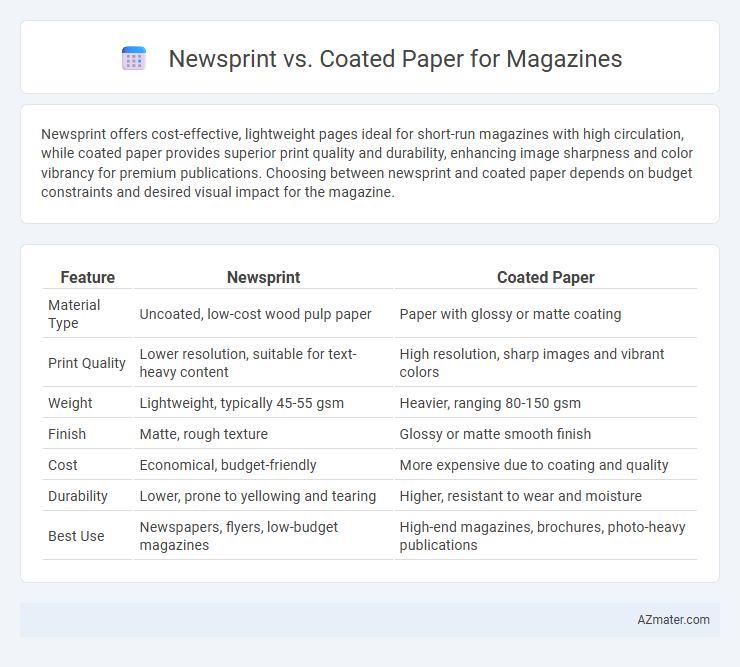Newsprint offers cost-effective, lightweight pages ideal for short-run magazines with high circulation, while coated paper provides superior print quality and durability, enhancing image sharpness and color vibrancy for premium publications. Choosing between newsprint and coated paper depends on budget constraints and desired visual impact for the magazine.
Table of Comparison
| Feature | Newsprint | Coated Paper |
|---|---|---|
| Material Type | Uncoated, low-cost wood pulp paper | Paper with glossy or matte coating |
| Print Quality | Lower resolution, suitable for text-heavy content | High resolution, sharp images and vibrant colors |
| Weight | Lightweight, typically 45-55 gsm | Heavier, ranging 80-150 gsm |
| Finish | Matte, rough texture | Glossy or matte smooth finish |
| Cost | Economical, budget-friendly | More expensive due to coating and quality |
| Durability | Lower, prone to yellowing and tearing | Higher, resistant to wear and moisture |
| Best Use | Newspapers, flyers, low-budget magazines | High-end magazines, brochures, photo-heavy publications |
Introduction to Newsprint and Coated Paper
Newsprint is an economical, lightweight paper primarily made from mechanical pulp, offering high opacity and good ink absorption, making it suitable for bulk printing like newspapers and mass-market magazines. Coated paper features a surface treated with a mixture of materials such as clay and calcium carbonate, providing a smooth, glossy or matte finish that enhances color vibrancy and sharpness, ideal for high-quality magazine images and detailed graphics. Choosing between newsprint and coated paper involves balancing cost, print quality, and the intended magazine's visual impact.
Key Differences in Material Composition
Newsprint is made primarily from mechanical wood pulp, resulting in a lower brightness and a more porous texture, while coated paper incorporates a layer of clay or calcium carbonate coating that enhances smoothness and brightness. The fiber composition of newsprint tends to be less refined, causing faster ink absorption and less sharp image reproduction, whereas coated paper's coating acts as a barrier to prevent ink penetration, allowing for sharper, more vibrant prints. These differences in material composition directly impact the visual quality and durability of magazine pages, with coated paper providing superior print clarity and newsprint offering a more economical, lightweight option.
Print Quality: Color Vibrancy and Image Sharpness
Newsprint offers a cost-effective option but often lacks the color vibrancy and image sharpness required for high-quality magazine prints, resulting in duller visuals and less defined details. Coated paper enhances print quality significantly, with its smooth surface enabling richer color saturation and sharper image reproduction, making it ideal for magazines prioritizing vivid and crisp visuals. For publishers aiming to maximize reader engagement through superior print aesthetics, coated paper provides a noticeable advantage in color intensity and detail clarity over newsprint.
Paper Durability and Lifespan
Newsprint offers limited durability and a shorter lifespan due to its low-quality fibers and high acidity, making it prone to yellowing and brittleness over time. Coated paper, enhanced with a protective layer, provides superior resistance to wear, moisture, and fading, significantly extending magazine longevity and maintaining print quality. This durability difference makes coated paper the preferred choice for premium magazines seeking long-term preservation and vibrant visuals.
Cost Comparison: Newsprint vs Coated Paper
Newsprint offers a significantly lower cost per square foot compared to coated paper, making it an economical choice for large-scale magazine production. Coated paper, while more expensive due to its superior finish and higher quality, enhances print sharpness and color vibrancy, justifying the increased investment for premium publications. Budget constraints often drive publishers to choose newsprint, whereas high-end magazines prioritize coated paper despite the higher material costs.
Environmental Impact and Sustainability
Newsprint, primarily made from wood pulp with minimal chemical processing, is broadly recycled and biodegradable, contributing to a lower environmental footprint in magazine production. Coated paper, treated with clay or polymers for enhanced print quality, involves more intensive manufacturing processes and poses challenges for recycling, often resulting in higher energy consumption and waste. Sustainable magazine publishing increasingly favors newsprint due to its better recyclability and reduced ecological impact compared to coated alternatives.
Reader Experience and Perceived Value
Newsprint offers a lightweight, matte finish that enhances readability by reducing glare, making it ideal for casual reading but often perceived as lower quality. Coated paper features a smooth, glossy or satin surface that enriches color vibrancy and sharpness, significantly elevating the magazine's perceived value and reader engagement. The tactile feel of coated paper also conveys premium quality, influencing readers' perception of content credibility and overall satisfaction.
Usage Trends in Modern Magazine Publishing
Newsprint remains popular for mass-market magazines due to its cost-effectiveness and recyclability, especially in high-circulation, short-lifecycle publications. Coated paper, favored in premium magazines, enhances image quality with a glossy or matte finish, supporting vibrant visuals and sharper text crucial for fashion and lifestyle genres. Modern magazine publishing increasingly blends these materials, using newsprint for bulk segments and coated paper for special issues to balance budget constraints with aesthetic appeal.
Suitability for Different Magazine Genres
Newsprint suits mass-market magazines and newspapers due to its affordability and quick ink absorption, ideal for high-volume circulation genres like tabloids and daily news publications. Coated paper enhances image sharpness and color vibrancy, making it the preferred choice for premium fashion, art, and lifestyle magazines that require rich visual presentation and longer shelf life. Choosing between newsprint and coated paper depends on balancing cost efficiency with desired print quality and audience expectations within specific magazine genres.
Choosing the Right Paper for Your Magazine
Selecting the right paper for your magazine hinges on the desired print quality and budget constraints. Newsprint offers a cost-effective solution with a rough texture, ideal for high-volume publications focusing on timely content but sacrifices vibrant color reproduction. Coated paper, available in matte, gloss, or silk finishes, enhances image sharpness and color vibrancy, making it suitable for premium magazines aiming to captivate readers with visually rich layouts.

Infographic: Newsprint vs Coated Paper for Magazine
 azmater.com
azmater.com